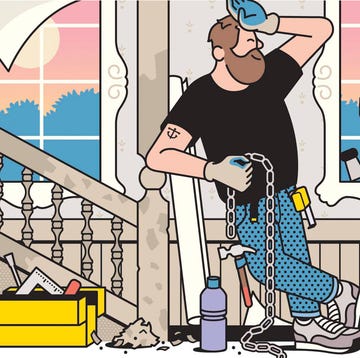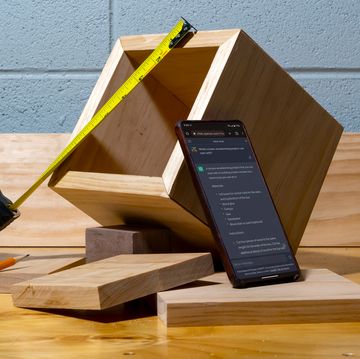Backyards in Brooklyn are almost always blessed with these glorious bluestone patios. Massive slabs the size of truck beds hold entire Adirondack chairs, and in the rain, water runs along the rivulets it has slowly carved in the stones' shimmering navy surface. Ask the owners where the stone was acquired, and the answer invariably comes back: "We just started digging, and there it was." I wanted a stone patio too, and I envied my friends' archeological good fortune. But a few exploratory digs and some random stabs with the Awesome Auger hadn't yet struck buried treasure, so I set off for the stone yard to start from scratch.
Hauling heavy materials in Brooklyn is not without its own eccentricities: I could hire one truck-driving Mr. Love to deliver the materials to my address, but he would only drop it off on the curb. To get it to the backyard, where I actually needed it, I had to hire someone else. My swelling staff of subcontractors didn't stop me from losing about half my body weight in sweat while laying this patio in a single weekend—the reason it's called hardscaping, I decided, is because it's some mighty hard work.
Project Overview
I chose 1-inch-thick Champlain Stone granite flagstones because their small size and weight kept each piece manageable. Thicker, heavier pieces would hold their positions better, but they were too expensive for my planned 120 square feet, and I imagined they'd be much harder to get (through the house) to the job site. My lightweight stones needed a multilayer foundation too keep them from shifting, sinking or being pushed out of position during seasonal frost-and-thaw cycles. I began by outlining the patio, digging down several inches in its planned location, then adding a couple of inches of crushed stone, a couple of inches of sand, and finally the paving stones on top. More sand, swept and packed into joints between the stones, acts as mortar to hold them in place. (At least, that's what I'm hoping—according to PM's "Build Your Own Stone Patio" story from 2006, I probably should have dug an even deeper foundation.)
Step-by-Step
1. Dig Out the Foundation
The first, most labor-intensive step (after the schlepping) is digging the footing for the patio. Begin by using a square-nose shovel to outline the patio perimeter. Loosen the soil within and scoop it out, tossing it either in buckets or a wheelbarrow so it can be easily relocated to planting beds or some inconspicuous mound. You're only going down a few inches, but even a shallow ditch spread out over 120 square feet adds up to a lot of digging. Fortunately, subcontractor Alan proved as deft with the shovel as he was at hauling 50-pound bags of crushed rock, one on each shoulder, up the stoop and through the house. He also had a great back-saving technique for ensuring a flat-bottomed hole: Place the back face of a square-nosed shovel flat against the earth, so that the butt of the handle hits around your hips. Then just keep your spine straight as you walk the shovel forward, plowing forward with your leg muscles while the shovel collects the loose dirt like a dustpan. At the end of the first day we had a shapely, flat-bottomed hole in the outline of the patio-to-be.
2. Spread the Crushed Stone
Some strategy here overlaps with chess: It's best to minimize the amount of moves you have to make to get the pieces in position. Unpile the heap of gravel bags, for instance, by tossing them into the pit at roughly the spots you expect they'll spread evenly. It may feel like you're overthinking it, but by the end of the project you'll be reluctant to bend over, even empty-handed. Using a utility knife, split the bags open like a fish belly and use the back side of a garden rake to start spreading an even layer throughout the pit. Pack the gravel down using a tamper.
3. Sprinkle the Sand
Like the rocks, toss the bags into position before cutting them all open. Again using the back of the garden rake, spread the sand evenly over the gravel. You'll be adding more sand in later steps, so don't worry about adding too much on this first layer. Building up the sand layer in certain spots is also a good way to raise any pieces that feel too low or out of level. But be careful not to bury any dogs that get in the way (above right).
4. Lay Out the Stones
Finally, the fun part. Arrange each stone over the sand bed. As you assemble the flagstone puzzle, step back frequently to take a look at how the overall picture is emerging. One of the reasons we chose the flagstone is that it allows a more casual, country-style path not bound by the rules and constraints of laying a brick or cobblestone walk. Even so, it's best to go for narrow, uniform spacing between the stones. Try to avoid sharp changes in grade from one stone to the next. We put the widest, flattest stones in the main field of the patio, and saved the smaller pieces for the less-trafficked path to the tool shed. Carefully walk over the pieces, or tap them down with a rubber mallet, to settle them firmly in the bed.
5. Fill the Joints
When you're satisfied with the entire patio's placement, pour more sand over the stones and sweep it into the gaps between them. Stone dust can also work for this step. To hold the stones more firmly in position, Alan suggested mixing one bag of cement for every six bags of sand. We skipped that step—we're hoping some creeping ground cover will grow between the stones, and it seemed the cement could block root growth. Once the sand is between the stones, use a garden hose to lightly wet the whole patio, rinsing off the stones and settling the sand in place. Don't be surprised if the sand seems to disappear completely after the first wetting. Just add some more, wet it again, and keep adding it until it forms a firm pack of mortar between the stones. I'll probably have to add more sand as things settle out—something to look forward to for next weekend.
Conclusion
The next day, when digging to do some planting along the patio edge, my shovel clunked against something solid buried about six inches down. I moved over a step, and got another clunk. A step in the other direction, and again, clunk. Can you guess where this is heading? I thought at first it was some buried oil tank, or maybe the coffin of some long-lost Brooklyn wiseguy. But when I reached the clunk-free edge—and especially when I exposed the cleft joint where two pieces met—I knew I had finally found my buried bluestone. The complete excavation yielded eight massive slabs, each two feet wide and some almost three feet long. (I shudder to imagine what Mr. Love would've charged to deliver that!) Now all I have to do is figure out where to put them—unfortunately, the best spot for a patio is already filled with flagstone.













